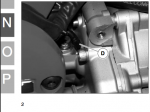-
Posts
20,507 -
Joined
-
Last visited
-
Days Won
1,189
Content Type
Profiles
Forums
Events
Gallery
Community Map
Everything posted by docc
-
Worth inspecting the gearbox input hub for failure of the safety washer ?
-
-
You're just buttering up our Chief Whip!
-
It really has been surprising just how tightly packaged the V11 is. To fabricate a fuel tank (or install a V10 Hi-cam!) is truly an amazement!
-
I used a cheap laser level to alignment my Sport's swingarm Not really sure how to rig that for Zooter's frame check . . .
-
Thank you, Sir! Just trying to contribute the outstanding documentation so others can put this to good use. Here is an image of the steel flywheel with the toothed gear/"chain ring" removed: And one showing the steel flywheel in the upper right:
-
Good image of the rear aspect of the clutch assembly and "toothed gear." The flywheel is not visible from this side (correct?) as the clutch resides inside of it and the toothed gear/"chain ring" bolts to it.
-
These are great images, yet I was always confused by my misunderstandings until I got it all apart and realized my history with cars had me confused. If I am correct the image above is the front of the actual flywheel that mates to the crankshaft. The toothed ring/"chain ring" that is turned by starter is mounted behind this and is not the actual flywheel as in the cars I have been accustomed to. Perhaps fueling my confusion, the flywheel is not numbered in the parts diagram for the clutch and is not actually considered part of the "clutch" assembly : The flywheel #19 (and "chain ring" #22) is, instead, shown with the crankshaft and piston/cylinder assembly: It probably has not helped that we have so often stated concerns about failure of the "single plate clutch" when, in fact, the clutch does not fail but the aluminum flywheel that was used with it on the Rosso Mandello, Scura, and Tenni that is the singular fail point. [Just a wee stab at some clarification for those that may be wading through our discourse. ]
-
A long known field expedient for a blocked V11 tank vent is to simply pry out the rubber seal (it's not exactly an "O-ring") on the bottom of the cap which, essentially causes it to vent "normally."
-
Really? All those random spaces are to be expected? What a disaster.
-
Ouch, buddy! That hurts just to look at . . . So, even though it looks like ferrous "rust" on some of the images, and a different metal interface at the front, the entire ("single plate") flywheel is aluminum? Should be totally straightforward for concerned owners of Rosso Mandello, Scura, and Tenni to test their flywheel with a magnet through the timing mark viewing port . . .
-
So, it appears the nefarious "aluminum" flywheel really is bi-metal with the flanks/sides steel and the friction surface and attachment points to the crankshaft aluminum (?)
-
Okay, how about the magnet test? (Not on the starter teeth, but on the side of the flywheel in front of that where the TDC marks are)....
-
The fuse block will actually pry up out of the rubber insulators without using the fasteners. A little at a time, back and forth between them.
-
Hmm, true that. I don't know why I thought that part of the flywheel was steel, while the friction surface was aluminum. Now that seems like such an implausible notion. Anyone with an original single plate flywheel (Rosso Mandello, Scura, Tenni) willing to put a magnet through the timing hole?
-
It rather surprised ,me when I took my V11 clutch apart, that the toothed plate that has the teeth for the starter to move is not actually the "flywheel" (like the old American V8s I am used to). The V11 "flywheel" is actually really deep in and anchored to the back of the crankshaft. Pretty sure there is no way to get a magnet onto that surface (?)
-
It's the SPOrT-1100/V11 DrJohn/Crane cam, no? And the compromise to make sure the valves seat long enough (loose enough) to cool through the seats? Early, tight (US?) valve clearances were more about noise control? Certainly not about longevity. P.Roper rightfully noted that the looser the valve lash, the less the lift and duration from the cam. Lower performance (?) Trade-offs!
-
Pretty sure it is not that the ECU had such a high ground demand, but that major ground demands (starter!!) were not being met and found their way back there. Also, be sure to add a ground strap from your regulator to the engine (timing chest). Make sure all your grounds, and connections, are clean, tight, and "treated" . . . Caig DeOxit®, baby!
-
This is a really excellent question for @Meinolf No doubt, his are the most thoroughly and precisely developed V11 maps, ever. What would be the effect of using the latest Meinolf map with the more typical, closer, valve clearances (0.15 & 0.20mm/ 0.006"/0.008") ?
-
All three?!? "Two is a coincidence, but three is a collection!"
-
The most likely culprit that would melt up the ground side of the harness is a corroded, failed main grounding point behind the seat latch lock at the rear of the gearbox on the right, perhaps along with corroded/loose/failed battery terminals. This fail can go really badly for the minimal grounding back through the harness along the frame . .
-
"Wiggle Test" is something I learned from a book on "Preparing the Ford Sierra for Motorsport" (The US Merkur XR4Ti). That thing made the V11 look like the pinnacle of engineering and design success. What the relay/fuse wiggle will not find are the nefarious, hidden spade connectors under the fuse block for Fuses #1/ECU and #2/Fuel/Ignition. One of those jiggles loose and it can drive you mad.
-
So, I had to go back and try to understand Kiwi_Roy's Go_Winkie set-up I added to Fuse#8 and figure out how to use it. It does not read the fuel/ignition circuit of Fuse#2/Relay#5 exactly as I recalled. Just not that simple . . . [No Go_Winkie indicator could also be a battery positive open.]
-
stewgnu gives us a "hey up!" on the possibility of the seat latch cable fouling (mithering, even!) the 5th relay/ base:
-
So, my seat latch cable is tied to the outboard side of the subframe tube well clear of the relays and bases. Thanks for the hey-up on that Stewgnu! Now I'm looking at my Go_Winkie wired into Fuse#8 (early electric petcock circuit) and wondering if it really reads the FI circuit correctly. Another topic, I know . . .







